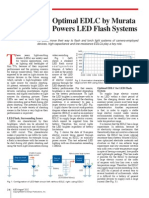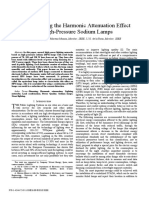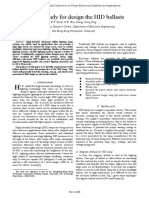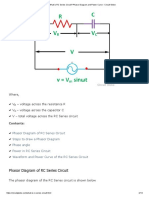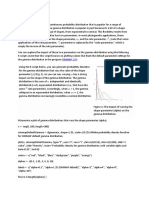Professional Documents
Culture Documents
Design of Low-Cost AC-Direct Driverless LED Luminaries With Non - Perceptible Flicker
Original Title
Copyright
Available Formats
Share this document
Did you find this document useful?
Is this content inappropriate?
Report this DocumentCopyright:
Available Formats
Design of Low-Cost AC-Direct Driverless LED Luminaries With Non - Perceptible Flicker
Copyright:
Available Formats
Volume 6, Issue 4, April – 2021 International Journal of Innovative Science and Research Technology
ISSN No:-2456-2165
Design of Low-Cost AC-Direct Driverless LED
Luminaries with Non – Perceptible Flicker
A.C.O. Azubogu 1, Obioma Peace C.2, Okwaraoka Chinedu P. A 3
1,2,3
Department of Electronic and Computer Engineering
Nnamdi Azikiwe University
Awka, Nigeria
Abstract:- Design considerations for a low cost and these other technologies when operating with the same power
efficient Light Emitting Diode (LED) luminaries involve rating.
numerous compromises. Factors such as efficiency,
power factor and flicker Index all present a compromise While LED’s present both an economical and efficient
against each other. It is conventional to employ suitable solution to lighting problems, the best way to power them
means that make for a low cost and efficient LED efficiently remains debateable. In the early stage, expensive
luminaire. In this paper, a driverless AC-Direct LED light engines and converters were mainly used for driving
luminaire with non-perceptible flicker, improved power LEDs. Most of these technologies depended on high voltage
factor, with acceptable total harmonic distortion (THD) Integrated Circuit (IC) switching chips for matching the
characteristics is designed. With a flicker index of 0.2, it number of LED strings during a power line cycle with the
outperforms most AC luminaires employing high voltage instantaneous power line voltage [8]. The major problem
switching chips, which have a typical flicker index associated with these LED drivers is that due to their poor
usually greater than 0.3. The efficiency is 88%, as against design and performance they greatly reduce the durability
80% achieved by most AC LED light engines. The design and cost of the lighting system.
has a THD of 18.79% and power factor of 0.92, this
meets Energy Star requirements for consumer products. Demands for higher efficiency, lower cost, and reduced
flicker content of the emitted light keeps increasing and
Keywords:- LED Luminaire, Flickerless LED, Driverless, spurring the implementation of improved techniques and
Low Cost, AC-Direct. products. By dividing the LED’s into sections, AC direct
driving techniques are employed to drive the LED’s without
I. INTRODUCTION need for a switching mode power supply (SMPS).
Globally, lighting forms a major part of energy In this paper, a driverless LED luminaire with non-
consumption worldwide. Lighting consumes about 25% of perceptible flicker, alongside improved power factor and
the world’s total electric energy [1]. Efficient lighting with total harmonic distortion (THD) characteristics is designed.
energy saving has become very vital. Consequently, current
light sources are expected to be designed to be highly II. CHARACTERIZING PHOTOMETRIC
efficient, environmentally friendly, energy saving, and should FLICKER
be able to deliver the required visual preference [2].
The Photometric flicker is a common phenomenon
Light Emitting Diode (LED) provides all the among light sources. Conventional light sources ranging
aforementioned properties, and with advancements in from incandescent lamps, High Intensity Discharge (HID),
technology, they are being deployed in mobile products and fluorescent, CFL, and LED’s all experience some degree of
backlighting of Liquid Crystal Display) LCD panels [3]-[4]. flicker. Photometric flicker is a characteristic of the light
Generally, LED lighting are majorly deployed in applications source resulting from power sources drawn from AC mains.
that require low-brightness illumination (e.g the screen According to the Illuminating Engineering Society of North
backlights of laptops and mobile phones), and high- America (IES) Lighting Handbook, flicker is defined as: “the
brightness illumination (which includes general lighting, rapid variation in light source intensity” [9]. The effect of
vehicle lighting, and backlighting of large television panels) light sources with flicker over a period of time on human
[5]-[6]. LED-based Solid State Lighting (SSL) is a promising observers can be very hazardous. This could lead to
energy saving technology to replace incandescent halogen, physiological effects and can have neurological
fluorescent tube, and Compact Fluorescent Light (CFL) in consequences. Light engines running on such rapid variations
the lighting industry. LED’s when compared to the are recognized as contributing to headaches and migraines
aforementioned technologies has a longer life span, about [10].
50,000 operational hours compared to 1000 – 2000 hours for
incandescent lamps and 5000 – 10,000 hours for CFL [7]. The adoption of driverless modules promising long life
LED’s also costs much less and has a higher luminosity than and quick return-on-investment in the market has been
greatly plagued by high flicker. The Illuminating Engineering
IJISRT21APR153 www.ijisrt.com 134
Volume 6, Issue 4, April – 2021 International Journal of Innovative Science and Research Technology
ISSN No:-2456-2165
Society (IES) developed two metrics to quantify flicker as
described in RP-16-10 (Nomenclature and Definitions for
Illuminating Engineering) [11]. The more commonly utilized
metric is percent flicker. The percent flicker helps to indicate
the average amount of modulation in light output over a
single on–off cycle. A Percentage flicker of 100% indicates
that at some point in its cycle, no light is produced. A light
source that is completely steady is said to have zero percent
(0%) flicker.
The other metric is the flicker index. This ranges from
zero to one. It accounts for the shape of the light’s waveform
and the duty cycle. A low value of percent flicker and flicker
index is desirable for non-perceptible flicker. Note that recent
findings indicate a new metric called Compact Flicker
Degree (CFD). This helps in evaluating the performance of
light engines that use higher frequencies (up to and beyond
2000Hz) for modulation of light [12].
Fig.1 Figurative description of flicker Index [13].
Flicker is inherent in Conventional light sources.
Incandescent lamps have a percentage Flicker of around III. TOPOLOGIES FOR THE DESIGN OF LED
10~20% [13], while magnetically ballasted CFL lamps have LUMINAIRE WITH NON-PERCEPTIBLE FLICKER
a rather high flicker of 37 ~ 70%. Though modern
electronically ballasted CFL lamps have lower Percent flicker I. The Basic Offline LED Driver
of around 5% [13]. The operation of a mains fed LED driver is used to
illustrate the reason behind the 100Hz/120Hz perceptible
Presently, there is no clearly stipulated standard flicker in offline LED lamps.
regarding the maximum acceptable flicker in LED lamps.
The percent flicker specified by manufacturers stipulates that
the percent flicker should be less than 30% in the 100Hz -
120Hz frequency range [13]. A stable LED driving current is
required to achieve a flicker free operation. According to
[13], there are two kinds of light flicker observable in LED
lamps:
• AC line frequency related light fluctuation (usually at
double the line frequency (100Hz for 50Hz line frequency
and 120Hz for 60Hz line frequency).
• Random light intensity fluctuation (often caused by
incompatibility between lamp and peripheral lighting
components).
According to research, flicker above 75Hz is usually Fig. 2 Basic Offline LED Driver [13].
not noticeable by most individuals. Although, the
perceptibility of flicker is not only related to frequency: it is The converter for most single stage offline LED
also related to the intensity of the peaks and valleys of the drivers consists of a Buck-Boost or flyback converter to
light output (intensity modulation) and duration of these convert the rectified line voltage into a suitable output
variations [13]. voltage for driving the LED string.
In such a system shown in figure 2, flicker-free
operation is achieved if the LED current ILED is a stable DC
current, and the LED voltage VLED is fixed. Since the line
voltage is sinusoidal, the circuit must contain a voltage
buffer element that would help to transform the alternating
current into DC voltage. This achieved using either of C1 or
C2 as shown in figure 2. [13].
IJISRT21APR153 www.ijisrt.com 135
Volume 6, Issue 4, April – 2021 International Journal of Innovative Science and Research Technology
ISSN No:-2456-2165
II. High Power Factor Applications
To control the flicker in a high PFC single stage LED
To design a system with high power factor that meets driver, the following procedure is followed [13]:
with the harmonic standards stipulated by IEC61000-3-2, the i. Characterize the maximum acceptable flicker
LED driver with an ac input incorporates Power Factor percentage requirement (about 30%)
Correction (PFC) control [14]. A unity power factor implies ii. Establish the maximum LED current peak to peak
that a pulsating power will be seen at the input side of the variation (IPP) from the Luminous Flux vs. forward
driver, while the output power is typically made constant to current curve.
drive the LEDs. To balance out the instantaneous power iii. Using the LED I/V curve, calculate the dynamic
difference between the pulsating input and the constant resistance (RD) of the LED at the operation point.
output an Electrolytic capacitor is usually employed for that. iv. Calculate the maximum peak to peak voltage ripple
(VPP) across all the LED string, mathematically, it is:
From figure 3, for good power factor with low input
harmonic current, the value of C1 must be kept small and the (𝑉𝑃𝑃 ) = (𝐼𝑃𝑃 ) ∗ (𝑅𝐷 ) (1)
converter must try to maintain a sine shaped input current as
well, requiring a low bandwidth control loop. The voltage v. Calculate the output capacitor value using equation (2):
buffer element (C2) is used to reduce the voltage ripple
across the LED string. A large value of C2 is required to
achieve very small LED voltage ripple. The LED current (IPP )
𝐶𝑂𝑈𝑇 = (V (2)
ripple and flicker is usually determined by the voltage ripple PP )∗2𝜋𝑓
along with the LED characteristics [13].
Where:
(IPP) is twice the average LED current and (VPP) is the
allowed peak to peak output voltage ripple across the LED
string
f is twice the line frequency.
IV. DESIGN PARAMETERS FOR THE AC –
DIRECT DRIVERLESS LED LUMINAIRE WITH
NON-PERCEPTIBLE FLICKER.
The design parameters for the LED luminaire are
chosen to match or exceed the photometric characteristics of
a two feet (2 feet) fluorescent light or a Compact Fluorescent
Light (CFL) down light luminaire at a reduced cost and
higher efficiency. Important photometric characteristics of
these light fixtures are compared in table 1.
Fig.3 High power factor converter [13].
TABLE 1
PHOTOMETRIC CHARACTERISTICS OF SOME LIGHT FIXTURES
*Source: Lamp manufacturers datasheet [15].
Characteristic CFL Value 2 ft. Fluorescent Value LED luminaire Value
Light Output (Lumen) 670* 950* 1026*
Power (Watts) 11 10 9
Efficacy (lm/W) 61 95 114
Correlated Colour Temperature 4000K 4000K 4000K
(CCT)
Two of the most important parameters in the design The LED used for this design is Cree XLAMP MX-6
process of any LED-based luminaire is the number of LED’s LED high brightness LED. Important parameters of the
required to meet the design goals and the effective XLAMP MX-6 LED are shown in Table 2.
capacitance of the circuit.
IJISRT21APR153 www.ijisrt.com 136
Volume 6, Issue 4, April – 2021 International Journal of Innovative Science and Research Technology
ISSN No:-2456-2165
TABLE 2
IMPORTANT PARAMETERS OF THE XLAMP MX-6 LED
Part Number Norminal CCT (K) Norminal Drive Typical Forward Typical Power Typical Efficacy
Current (mA) Voltage (V) (W) (lm/W)
XLAMP MX-6 4000 300 3.3 1 114
To effectively determine the number of LED’s needed, Thus a minimum of 12 LEDs of 114 lm @ 300mA
the inefficiencies contributed by the optical, thermal and operating current per LED wired in series are needed to
electrical systems is estimated as follows. satisfy the light output design goal.
Optical Loss: Optical system efficacy is estimated by The effective capacitance Ceff represents the combined
examining light losses due to Secondary Optics and capacitance of the Power Factor Corrector (PFC) circuit
fixture Light loss. Fixture light loss arises when the light during the discharge period. The effective capacitance of the
source strikes the fixture housing before hiting the target. PFC circuit is given as:
The efficiency of the fixture depends on the placement of
the LED’s, the fixture shape and material. The structure 𝐶𝑒𝑓𝑓 = (𝐶1//𝐶3) + (𝐶2//𝐶4) (5)
for the designed LED luminaire is such that the LED’s
emit optical light directionally, removing the need for Different capacitor values yields different values of
reflectors; hence only secondary optical loss due to the power factor and THD %. According to [16], the best
diffuser placed over the LED’s is considered. The combination of capacitors that yields the highest PF and
generally accepted optical efficiency through the lowest THD is when 𝐶1 = 𝐶4 = 𝐶 and 𝐶2 = 𝐶3 = 𝐶/2.
secondary optical element lies within 85% and 90%. An Substituting this condition into equation () yields:
optical efficiency of 88% is assumed in this design.
Thermal Loss: This is due to decrease in relative 𝐶𝑒𝑓𝑓 = 3𝐶/4. (6)
luminous flux output of the LED as junction temperature
(Tj) rises. Most LED data sheets list typical luminous The Output Power (Po), estimated Efficiency (ƞ),
flux at Tj = 25°C, while most LED applications use normal discharge period (tnormal), holdup time requirement
higher temperatures. A Junction temperature Tj = 80°C is (tholdup) and effective capacitance (Ceff) can be calculated
assumed which corresponds to a minimum relative flux from the following equation:
of 80% from the LED’s datasheet [15]. 85% relative
luminous flux is the thermal efficacy estimate used in the 2(𝑃𝑜 )(𝑡ℎ𝑜𝑙𝑑𝑢𝑝 + 𝑡𝑛𝑜𝑟𝑚𝑎𝑙 )
𝐶𝑒𝑓𝑓 = ƞ(𝑉𝑠2 −𝑉𝑓2 )
(7)
design.
Electrical Loss: Electrical loss is inherent in electrical
devices, for the system designed; an efficiency of 88% is Where 𝑉𝑠 and 𝑉𝑓 are the designated initial and final voltage,
achieved. Most typical LED drivers has an efficiency respectively, in the entire discharge period.
between 80% and 90%.
The normal discharge period (tnormal) is 4ms for 50Hz
The exact number of LED lumens that is required to AC, while the holdup time requirement (tholdup) is 5ms. The
achieve the design goals is calculated considering only the circuit starts discharging at around two-third of input voltage
light efficiencies. Electrical efficiency does not affect the and assume 15% voltage ripple during discharge, thus:
amount of light produced by the luminaire. This is calculated
as shown below: 2
𝑉𝑠 = 3
√2 (𝑉𝑅𝑀𝑆 ) (8)
𝑇𝑎𝑟𝑔𝑒𝑡 𝐿𝑢𝑚𝑒𝑛𝑠
𝐴𝑐𝑡𝑢𝑎𝑙 𝐿𝑢𝑚𝑒𝑛𝑠 = (𝑂𝑝𝑡𝑖𝑐𝑎𝑙 𝐸𝑓𝑓𝑖𝑐𝑖𝑒𝑛𝑐𝑦)∗(𝑇ℎ𝑒𝑟𝑚𝑎𝑙 𝐸𝑓𝑓𝑖𝑐𝑖𝑒𝑛𝑐𝑦) 2
(3) 𝑉𝑠 = √2 (230) = 216.84𝑉
3
1026
𝐴𝑐𝑡𝑢𝑎𝑙 𝐿𝑢𝑚𝑒𝑛𝑠 = ≃ 1,372 𝑙𝑚
(88%) ∗ (85%) 𝑉𝑓 = (1 − 0.15)𝑉𝑠 (9)
The number of LED’s required to produce this amount 𝑉𝑓 = (1 − 0.15)(216.84) = 184.32V
of lumen depends on the operating current. For the LED
used (XLAMP MX-6 LED), the operating current is 300mA. 2(𝑃𝑜 )(𝑡ℎ𝑜𝑙𝑑𝑢𝑝 + 𝑡𝑛𝑜𝑟𝑚𝑎𝑙 )
𝐶𝑒𝑓𝑓 =
ƞ(𝑉𝑠2 − 𝑉𝑓2 )
Therefore:
𝐴𝑐𝑡𝑢𝑎𝑙 𝐿𝑢𝑚𝑒𝑛𝑠 𝑁𝑒𝑒𝑑𝑒𝑑 2(9)(0.004 + 0.005)
𝑁𝑢𝑚𝑏𝑒𝑟 𝑜𝑓 𝐿𝐸𝐷𝑠 = (4) 𝐶𝑒𝑓𝑓 = = 14.11𝜇𝑓
𝐿𝑢𝑚𝑒𝑛𝑠 𝑝𝑒𝑟 𝐿𝐸𝐷 0.88(216.842 − 184.322 )
1372 𝑙𝑚
= = 12.04 𝐿𝐸𝐷𝑠
114 𝑙𝑚
IJISRT21APR153 www.ijisrt.com 137
Volume 6, Issue 4, April – 2021 International Journal of Innovative Science and Research Technology
ISSN No:-2456-2165
4 diode is reverse-biased. At this point, the capacitor pairs
𝐶= 𝐶 = 18.81𝜇𝑓
3 𝑒𝑓𝑓 discharges in series to provide the output current.
In the actual design, 20 𝜇𝑓/250𝑉 electrolytic capacitor was At the zero crossing level, the Line voltage changes
used for C. direction but is lower than the valley fill voltage. Thus, the
input current still flows through the path R1-C10-D3. The
whole charging/discharging cycle repeats at the next half
V. CONTROL CIRCUITRY OF DRIVERLESS AC – line cycle when the input voltage is higher than the voltage
DIRECT LED LUMINAIRE WITH REDUCED sum of (VC1 +VC2), (VC3 +VC4) or (VC1 + VC4).
FLICKER.
Capacitors C9 and C10 are introduced to increase the
The harmonic input currents drawn from AC mains by conduction time of the input current, they provide an
the conventional bridge-diode rectifier with a large bulk alternate path for the input current to flow into the Valley fill
capacitor connected to its output led to the passive power circuit before the input line voltage rises above the Valley
factor correction approach adopted in this design. The circuit fill circuit voltage [16]. This helps to decrease the current
employed in this work is as shown in Fig.4. distortion. Their values are chosen to be smaller than that of
the capacitors in the PFC circuit. There are chosen after
deciding the value of the effective capacitance of the circuit.
Resistor’s R2 and R3 are introduced to reduce the
inrush current into the PFC circuit and to also suppress
current distortion by limiting and smoothing the peak diode
charging current. The power dissipated by these resistors is
only a fraction of the input power; therefore they wouldn’t
impact greatly on the efficiency of the system. For a hold up
time of 5mS at 0.92 power factor, 20Ω resistors were used.
According to Yanchao Method for Single-Phase
Rectifier [17], the distortion factor due to the waveform
distortion has a similar property to reactive power. The input
capacitor C11 was introduced to compensate this reactive
power. It absorbs the harmonic distortion power so as to
Fig.4 Circuit diagram for the driverless and flickerless LED yield higher power factor and lower THD. The distortion
Luminaire factor is related to the THD as shown below:
Considering the circuit diagram in fig. 4, an improved 1
𝐷𝑖𝑠𝑡𝑜𝑟𝑡𝑖𝑜𝑛 𝐹𝑎𝑐𝑡𝑜𝑟 = √1+ 𝑇𝐻𝐷 2 (10)
valley fill circuit is introduced to replace the bulk
electrolytic capacitor and hence make for better power factor
correction. When AC voltage is applied to the circuit, in the Where,
first instance, the line voltage would be slightly higher than 2
√∑𝑛 ≠1 𝐼𝑛_𝑅𝑀𝑆
the voltage across either of (VC1 +VC2), (VC3 +VC4) or (VC1 + 𝑇𝐻𝐷 = (11)
𝐼1_𝑅𝑀𝑆
VC4). Consequently, the bridge diode conducts and the Input
current flows to the output load directly. With time, the line
These all relate to the power factor in the expression
voltage rises slightly above the voltage sum, (VC1 + VC3 +
given below:
VC4) or (VC1 + VC2 + VC4) and starts charging the capacitor
pair with lower voltage first.
𝑃𝑜𝑤𝑒𝑟 𝐹𝑎𝑐𝑡𝑜𝑟 = 𝐷𝑖𝑠𝑝𝑙𝑎𝑐𝑒𝑚𝑒𝑛𝑡 𝐹𝑎𝑐𝑡𝑜𝑟
× 𝐷𝑖𝑠𝑡𝑜𝑟𝑡𝑖𝑜𝑛 𝐹𝑎𝑐𝑡𝑜𝑟 (12)
In this design, C2 = C3, therefore they will all charge
up at the same time and the input current charges the
𝐷𝑖𝑠𝑡𝑜𝑟𝑡𝑖𝑜𝑛 𝐹𝑎𝑐𝑡𝑜𝑟 = 𝐶𝑜𝑠 (𝜃𝑣 − 𝜃𝑖 ) (13)
capacitors and flows to the load the same time.
Where, 𝜃𝑣 and 𝜃𝑖 are the phase of the voltage and current
Unlike the conventional large bulk capacitor, the input
current still flows to the load rather than remaining at the respectively.
peak input voltage and preventing the input current from
flowing as the input voltage decays. The PFC circuit allows VI. EXPERIMENTAL RESULT
the input current to still flow to the load because the valley-
fill voltage stays around two-third of the peak input voltage. The proposed circuit was simulated and tested at a
This lengthens the conduction time for bridge diodes power level of 9W and input voltage of 230V (RMS).
compared to the conventional rectifier. When the input Simulation and experimental results are presented in Table
3. The waveform of the input voltage, the input current and
voltage decreases and falls below two-third of the input peak
voltage, the input current stops flowing because the bridge
IJISRT21APR153 www.ijisrt.com 138
Volume 6, Issue 4, April – 2021 International Journal of Innovative Science and Research Technology
ISSN No:-2456-2165
the output voltage of the experimental circuit are shown in
Figs. 5 and 7.
Fig. 8 Fourier analysis of the Conventional Circuit
Fig. 5 Operating Waveforms of the circuit
Fig. 9 Fourier analysis of the PFC Circuit
Fig. 6 Input current waveform of the conventional circuit TABLE 3
SIMULATION AND EXPERIMENTAL RESULTS
Parameter Simulation Measured
Value Value
Input Power 10W 10.18W
Input Voltage 170- 170- 230V(RMS)
Range 230V(RMS)
Output Power 9W 8.96W
Efficacy - 114lm/w
Efficiency 90% 88%
Power Factor 0.95 0.92
Flicker Index - 0.2
The LED strings are subdivided into four equal sub
segments as shown in Figure 4. From figure 5, the top sub
segment of the LED is shorted out during the positive half
cycles, while the bottom sub segment is shorted out during
the negative half cycles. When the input voltage turns
positive, C5 charges up through R5, and C6, which previously
was charged to the negative peak of the line voltage,
Fig. 7 Input current waveform of the PFC circuit receives current passing through the lower three strings. This
produces the first hump (of displacement current) seen in the
combined LED current waveform in Fig. 5. When C 5 is
IJISRT21APR153 www.ijisrt.com 139
Volume 6, Issue 4, April – 2021 International Journal of Innovative Science and Research Technology
ISSN No:-2456-2165
charged sufficiently, galvanic current starts passing through ACKNOWLEDGEMENTS
R4 leading to the second hump in the combined LED current
waveform of Figure. 5. A complementary series of the This project is being done under the Tertiary Education
described charging and discharging events happens during Trust Fund (TETFund) Institution Based Research Fund
negative half cycles. C5 and C6 stops about half of the LED (IBRF), Grant No.: 2014-2015-2016 TETFund Research
current from going through the resistors at all, which helps Projects Intervention (IRP). The support of TETFund is
to boost the system efficiency to over 90% without the immensely appreciated. The authors would like to thank all
protection circuitry. the staff of Electronics Lab, ECE department, Nnamdi
Azikiwe University.
The frequency of the rectified voltage is twice the
input frequency, the LED arrangement is such that it REFERENCES
illuminates at twice the frequency of the input voltage
alternately by the upper and lower strings. LED’s from the [1]. Lay-Ekuakille, F. D., Smart control of road-based LED
upper string is located close to a corresponding LED from fixtures for energy saving, IEEE 5th International
the lower string, so that the combination of the two produces Workshop on Intelligent Data Acquisition and
light continuously. This arrangement makes for non- Advanced Computing Systems (IDAACS), September
perceptible flicker even though individual elements of the 21-23, 2009, Cosenza, Italy.
array are only activated at a frequency of 50 Hz. [2]. Tsao, J., Roadmap projects significant LED
penetration of lighting market by 2010, Laser Focus
Fast Fourier Transform of the input currents of both World, May 2003, pp. 11–14.
the conventional circuit and the passive PFC circuit was [3]. Sammarco, J. J., Reyes, M. A., Bartels, J. R., and
performed and is shown in Fig. 8 and 9. From the analysis in Gallagher, S., Evaluation of Peripheral Visual
Fig. 8 and 9, it is shown that even the fifth harmonic Performance When Using Incandescent and LED
component of the conventional rectifier circuit contributes Miner Cap Lamps, IEEE Transactions on Industry
significantly to the input harmonic current and hence the Applications (TIA), Vol. 45, November-December.
main cause of low power factor and high THD. However, on 2009 pp. 1923-1929.
application of the PFC, almost all the harmonic components [4]. Brite, J., LED market grew by 93% in 2010, driven by
are suppressed yielding a THD of 18.79% and power factor backlights, LEDs magazine, February 2011.
of 0.92. The reasons for THD reduction and power factor http://ledsmagazine.com/news/8/2/26.
improvement in the PFC circuit were explained in section 5. [5]. H. Liu, Y. Yu, and X. Liu, The Research of
Humanized Design of the LED Landscape Lighting
The output current waveform has a flicker index of 0.2, Lamp, IEEE 10th International Conference on
lower than is achievable by most light engines employing Computer-aided Industrial Design & Conceptual
complex and expensive driver chips. The prototype has a Design (CAID&CD), November 2009, pp. 499–502.
Varistor and a current limiting resistor incorporated into it to [6]. D. Yoo G. Jeong, LCD panal sector-dimming
enable protection of the device which reduced the efficiency controlled high efficiency LED backlight drive system.
to 88%, otherwise an efficiency of over 90% is achievable International Conference on Electrical Machines and
with this design depending on the values of the limiting Systems, November 2009, pp. 1–6.
resistors used. [7]. Paladugu, Jayalakshmi, Effect of mechanical vibrations
on light emitting diode luminaires, Ph.D. dissertation,
The fixture housing was made of a light 22-gauge Dept. Elect. Eng., Univ. of Nevada, Las Vegas, 2009.
galvanized metal sheet. For the secondary optics; a frosted [8]. Junsik Kim and Shihong Park, A Direct AC Driver
diffuser cover was printed with a 3D printer. with Reduced Flicker for Multiple String LEDs.
Journal of Semiconductor Technology and Science,
VII. CONCLUSION vol.15, n.3, June, 2015, pp.1598-1657.
[9]. M. S. Rea., Lighting handbook: Reference and
This simple, low cost circuit outperforms most application, Illuminating Engineering Society of North
conventional AC LED products. Eventhough the active America (IESNA), 9th Edition, New York, 2000.
power factor correction approach has higher power factor [10]. A.J. Wilkins, I. Nimmo-Smith, A.I. Slater, Fluorescent
and lower total harmonic distortion compared to the passive lighting, headaches and eyestrain, Lighting Research
power factor correction approach, the shortfalls of such and Technology, March 1989, pp. 11-18.
systems are higher cost, circuit complexity, poor efficiency, [11]. Optical Flicker in Lighting, Energy Focus, Retrieved
and Electromagnetic Interference (EMI) issues. The September 2018, from
proposed circuit has no inductor, which is the bulkiest and https://www.energyfocus.com/wp-
largest component for conventional LED driver circuits content/.../032718_FlickerWhitepaper_Locked.pdf
employing the boost Power Factor Corrector (PFC) [12]. Peter Erwin, P. S., Understanding a new flicker metric
converter; this makes the circuit smaller when compared to and its application to AC-LED light engines. Retrieved
existing ones. Switching loss associated with the circuit September 2018, from LEDsmagazine.com, April,
operation is also eliminated and hence permits the use of 2017.
normal standard diodes, consequently reducing cost.
IJISRT21APR153 www.ijisrt.com 140
Volume 6, Issue 4, April – 2021 International Journal of Innovative Science and Research Technology
ISSN No:-2456-2165
[13]. Roy R. v., Minimizing Light Flicker in LED Lighting components/products/xlamp-leds-discrete/xlamp-mx-6.
Applications, Richtek Technology Corporation [16]. Dylan Dah-Chuan Lu, Analysis of an AC-DC Valley-
Application note AN022, July 2014. Fill Power Factor Corrector (VFPFC), ECTI
[14]. Shu Wang X.R, Kai Y.S, Yang Y., Zhihong Y., A Transactions On Electrical Eng.,Electronics and
Flicker-Free Electrolytic Capacitor-Less AC–DC LED Communications vol.5, n.2 August 2007.
Driver, IEEE Transactions on Power Electronics , vol. [17]. Hussein A. Kazem, Single-Phase Rectifier with Novel
27 n. 11, November 2012, pp. 4540 – 4548. Passive Waveshaping Filter, International Journal of
[15]. Xlamp-mx-6 datasheet, retrieved september 2018 from Applied Engineering Research, 2009, pp. 435–444.
https://www.cree.com/led-
AUTHORS’ INFORMATION
1
Lecturer, Department of Electronic and Computer Engineering, Nnamdi Azikiwe University, Awka, Anambra State, Nigeria.
2
Lecturer, Department of Electronic and Computer Engineering, Nnamdi Azikiwe University, Awka, Anambra State, Nigeria.
3
Lecturer, Electrical and Electronics Engineering Department of Federal, Polytechnic Nekede, Owerri, Imo State, Nigeria.
A.C.O. Azubogu hold B.Eng (Electronic Engineering) from the prestigious University of Nigeria, Nsukka;
M.Eng (Telecommunication) from University of Port Harcourt and Ph.D (Adaptive Signal Processing and
Wireless Communication) from Nnamdi Azikiwe University, Awka.
He has over 30 papers published in reputable international journals. He is presently a Professor in the
department of Electronic and Computer Engineering, Nnamdi Azikiwe University, Awka.
Mr. Azubogu is also a research associate with the Center for Sustainable Development (CSD) and the Center of
Excellence for Renewable Energy Development and Environmental Conservation (CEREDEC) at Nnamdi Azikiwe University.
He is married with two beautiful children. He can be reached by phone on +2348059626829 and through E-mail:
ac.azubogu@unizik.edu.ng or austinazu@yahoo.com.
Obioma Chibueze Peace received the B.Eng. degree in communication engineering from Nnamdi Azikiwe
University, Awka, Anambra state, Nigeria, in 2014. He is currently working toward the Master’s degree in the
department of Electronic and Computer Engineering, Nnamdi Azikiwe University. He has carried out research
on various LED lighting and display systems with focus on efficient and cost effective designs. He has
published works on Renewable Energy and Electric Vehicle Integration in Smart Grids, Overview of Internet
of Things technologies, etc. and has conference proceedings on Design of Low-Cost Driverless LED
Luminaries.
His research interests include Embedded System programming and design, Internet of Things technologies and LED based
intelligent lighting systems. He can be reached via email: obiomapeace2015@gmail.com.
Okwaraoka Chinedu P. A. Obtained his M.Eng in computer and control engineering, Nnamdi Azikiwe
University, Awka, Anambra State, Nigeria, in 2017. PGD in computer and control engineering, Nnamdi
Azikiwe University, Awka, Anambra State, Nigeria, 2014. HND in electrical and electronics engineering,
Federal Polytechnic Nekede, Owerri, Imo State, Nigeria, 2008.
He has published work on embedded fuzzy logic controller for battery charging systems, cost effective solar
charge controller for Li-ion batteries, LED light alternative for incandescent lighting systems, etc. He had
carried out research into various renewable energy generation, control and conversion techniques, and is
currently working on development of standalone self excited energy generation system suitable for rural environments.
Mr. Okwaraoka is currently teaching electrical electronics engineering technology at Electrical and Electronics Engineering
Department of Federal Polytechnic Nekede, Owerri, Imo State, Nigeria.
He can be reached via email: nodumbu@yahoo.com
IJISRT21APR153 www.ijisrt.com 141
You might also like
- Design of An Intelligent Universal Driver Circuit For LED LightsDocument9 pagesDesign of An Intelligent Universal Driver Circuit For LED LightsraghuNo ratings yet
- Ea 40Document6 pagesEa 40Harsh SharmaNo ratings yet
- An Improved Dimmable LED Driving Scheme With Low Flicker Metrics For Low Voltage ApplicationDocument8 pagesAn Improved Dimmable LED Driving Scheme With Low Flicker Metrics For Low Voltage ApplicationAritra DasguptaNo ratings yet
- Yadlapalli Et Al-2019-International Journal of Energy ResearchDocument19 pagesYadlapalli Et Al-2019-International Journal of Energy Researchjeos20132013No ratings yet
- A Novel On-Chip Step-Dimmer For Low Cost AC-powered HV-LED DriverDocument10 pagesA Novel On-Chip Step-Dimmer For Low Cost AC-powered HV-LED DriverWarda NAÏLINo ratings yet
- Led Driver ThesisDocument8 pagesLed Driver Thesisdeborahquintanaalbuquerque100% (2)
- Sustainability 13 09753 v3Document22 pagesSustainability 13 09753 v3Le ProfesseurNo ratings yet
- EDCL Aplicación Ta1263 PDFDocument2 pagesEDCL Aplicación Ta1263 PDFNadia BuenoNo ratings yet
- LED Backlight System and Power Solutions: Application NoteDocument14 pagesLED Backlight System and Power Solutions: Application NoteGabriel TorresNo ratings yet
- Harmonic Pada Lampu LedDocument4 pagesHarmonic Pada Lampu LedUnedo ParhusipNo ratings yet
- 7.8 Led MarketDocument21 pages7.8 Led MarketbumbacumbaNo ratings yet
- A Robust Driver For RGB LEDsDocument6 pagesA Robust Driver For RGB LEDsJephte LaputNo ratings yet
- Intelligent Lighting Control With LEDs For Smart HomeDocument6 pagesIntelligent Lighting Control With LEDs For Smart HomeJian ze LeeNo ratings yet
- Assets Application - Notes Indication Getting To Know LEDsDocument8 pagesAssets Application - Notes Indication Getting To Know LEDsyugimoto2005No ratings yet
- LED Backlight WhitepaperDocument12 pagesLED Backlight Whitepaperalguien1972No ratings yet
- A High-Voltage Sic-Based Boost PFC For Led ApplicationsDocument10 pagesA High-Voltage Sic-Based Boost PFC For Led Applicationsjhon jairo gomez solanoNo ratings yet
- Elimination of Electrolytic Capacitor in AC/DCDocument11 pagesElimination of Electrolytic Capacitor in AC/DCVanessa McclainNo ratings yet
- LED Luminaire Design GuideDocument15 pagesLED Luminaire Design GuideAnonymous SOQFPWBNo ratings yet
- Vol - 2 - Mak - 3 - ID912854 A Single-Stage LED DriverDocument9 pagesVol - 2 - Mak - 3 - ID912854 A Single-Stage LED DriverBulut M.No ratings yet
- Led DriverDocument38 pagesLed DriverManish Gaur0% (1)
- Led Lighting Thesis PDFDocument6 pagesLed Lighting Thesis PDFWriteMyEnglishPaperForMeSterlingHeights100% (2)
- Intelligent Traffic Light ControllerDocument80 pagesIntelligent Traffic Light ControllerBharat Pratap Singh SlathiaNo ratings yet
- Led Lighting Control PDFDocument15 pagesLed Lighting Control PDFDileepa619100% (1)
- LED Lights PDFDocument20 pagesLED Lights PDFAnuj ShroffNo ratings yet
- An Analysis of Harmonic Diversity Factors Applied To LED LampsDocument5 pagesAn Analysis of Harmonic Diversity Factors Applied To LED LampsEduardo Lourenco De SousaNo ratings yet
- Area Light Reference DesignDocument11 pagesArea Light Reference DesignAbraham Seco ArmestoNo ratings yet
- Measurement: Sohel Uddin, Hussain Shareef, Azah MohamedDocument13 pagesMeasurement: Sohel Uddin, Hussain Shareef, Azah MohamedRodrigo CavalcantiNo ratings yet
- Lee2016 PDFDocument24 pagesLee2016 PDFvenneti kiranNo ratings yet
- LED PresentationDocument15 pagesLED PresentationSunidhi MohapatraNo ratings yet
- Features Structure Operating PrincipleDocument12 pagesFeatures Structure Operating PrincipleOcta WisnuNo ratings yet
- The Transition To Led Illumination: A Case Study On Energy ConservationDocument5 pagesThe Transition To Led Illumination: A Case Study On Energy ConservationTarun ImandiNo ratings yet
- CarlsonDocument6 pagesCarlsonjoeykenyattaNo ratings yet
- Automatic Street Light ControlDocument41 pagesAutomatic Street Light ControlP.r. Suvankar67% (3)
- LED Lighting Energy SavingsDocument12 pagesLED Lighting Energy SavingsSai KishoreNo ratings yet
- LED LightingDocument3 pagesLED LightingRiad El AbedNo ratings yet
- Cao Zhu Wu IEEE APEC 2020Document7 pagesCao Zhu Wu IEEE APEC 2020Humberto van OolNo ratings yet
- Leds in LCD Backlighting For AutomotiveDocument3 pagesLeds in LCD Backlighting For AutomotiveBudi SulaimanNo ratings yet
- 2 Unit 2 Hardware Design - DigitalDocument51 pages2 Unit 2 Hardware Design - DigitalAyush SinghNo ratings yet
- LED Lighting Design GuideDocument34 pagesLED Lighting Design Guidenicholas_j_vaughanNo ratings yet
- General Study For Design The HID BallastsDocument4 pagesGeneral Study For Design The HID BallastsSebastian CostaNo ratings yet
- Applications and Working of LEDsDocument10 pagesApplications and Working of LEDsSaurabh KhareNo ratings yet
- LED Street LightingDocument4 pagesLED Street LightingmswgtsNo ratings yet
- Infineon General - Lighting - LED ApplicationBrochure v05 - 00 EN PDFDocument48 pagesInfineon General - Lighting - LED ApplicationBrochure v05 - 00 EN PDFKUNDAN GHARATNo ratings yet
- Induction and LED Lighting: An Overview of Interior ApplicationsDocument18 pagesInduction and LED Lighting: An Overview of Interior ApplicationsShantkumar S SambargimathNo ratings yet
- Research Paper On LedDocument4 pagesResearch Paper On Ledgzrvpcvnd100% (1)
- Wibowo 2021 J. Phys. Conf. Ser. 1803 012023Document9 pagesWibowo 2021 J. Phys. Conf. Ser. 1803 012023DiepMiuDiepMiuNo ratings yet
- Luminaire EfficacyDocument2 pagesLuminaire EfficacyIulian BadoiNo ratings yet
- LED Tech ManualDocument40 pagesLED Tech ManualTomislav VratićNo ratings yet
- Led Driver Thesis PDFDocument8 pagesLed Driver Thesis PDFraxdouvcf100% (2)
- MediaDocument4 pagesMediaB-12No ratings yet
- Bidirectional Grid-Tie Flyback Converter Applied ToDocument9 pagesBidirectional Grid-Tie Flyback Converter Applied ToArceu CamposNo ratings yet
- LED Lighting Design GuideDocument34 pagesLED Lighting Design GuideFormerru100% (1)
- Ons LedDocument35 pagesOns LeddenisandreiNo ratings yet
- Castro Vazquez Lamar Arias Hernando Sebastian IEEE Journal of Emerging and Selected Topics in Power Eletronics 2019Document16 pagesCastro Vazquez Lamar Arias Hernando Sebastian IEEE Journal of Emerging and Selected Topics in Power Eletronics 2019Humberto van OolNo ratings yet
- The Health Benefits of LED Lighting: Circadian Rhythms, Sensors & NetworksDocument5 pagesThe Health Benefits of LED Lighting: Circadian Rhythms, Sensors & NetworksrajuanthatiNo ratings yet
- Automotive LEDs ContinueDocument3 pagesAutomotive LEDs ContinueAjay GuptaNo ratings yet
- Cell Phone Controlled Audio/Video Mute Switch: Maharishi ArvindDocument30 pagesCell Phone Controlled Audio/Video Mute Switch: Maharishi Arvindbobbyjain20No ratings yet
- A Flicker-Free Single-Stage Offline LED Driver With High Power FactorDocument12 pagesA Flicker-Free Single-Stage Offline LED Driver With High Power FactorShaheer DurraniNo ratings yet
- The Making of Self-Disposing Contactless Motion-Activated Trash Bin Using Ultrasonic SensorsDocument7 pagesThe Making of Self-Disposing Contactless Motion-Activated Trash Bin Using Ultrasonic SensorsInternational Journal of Innovative Science and Research TechnologyNo ratings yet
- Exploring the Clinical Characteristics, Chromosomal Analysis, and Emotional and Social Considerations in Parents of Children with Down SyndromeDocument8 pagesExploring the Clinical Characteristics, Chromosomal Analysis, and Emotional and Social Considerations in Parents of Children with Down SyndromeInternational Journal of Innovative Science and Research TechnologyNo ratings yet
- Intelligent Engines: Revolutionizing Manufacturing and Supply Chains with AIDocument14 pagesIntelligent Engines: Revolutionizing Manufacturing and Supply Chains with AIInternational Journal of Innovative Science and Research TechnologyNo ratings yet
- Advancing Opthalmic Diagnostics: U-Net for Retinal Blood Vessel SegmentationDocument8 pagesAdvancing Opthalmic Diagnostics: U-Net for Retinal Blood Vessel SegmentationInternational Journal of Innovative Science and Research TechnologyNo ratings yet
- Handling Disruptive Behaviors of Students in San Jose National High SchoolDocument5 pagesHandling Disruptive Behaviors of Students in San Jose National High SchoolInternational Journal of Innovative Science and Research TechnologyNo ratings yet
- Natural Peel-Off Mask Formulation and EvaluationDocument6 pagesNatural Peel-Off Mask Formulation and EvaluationInternational Journal of Innovative Science and Research TechnologyNo ratings yet
- Beyond Shelters: A Gendered Approach to Disaster Preparedness and Resilience in Urban CentersDocument6 pagesBeyond Shelters: A Gendered Approach to Disaster Preparedness and Resilience in Urban CentersInternational Journal of Innovative Science and Research TechnologyNo ratings yet
- Placement Application for Department of Commerce with Computer Applications (Navigator)Document7 pagesPlacement Application for Department of Commerce with Computer Applications (Navigator)International Journal of Innovative Science and Research TechnologyNo ratings yet
- Fruit of the Pomegranate (Punica granatum) Plant: Nutrients, Phytochemical Composition and Antioxidant Activity of Fresh and Dried FruitsDocument6 pagesFruit of the Pomegranate (Punica granatum) Plant: Nutrients, Phytochemical Composition and Antioxidant Activity of Fresh and Dried FruitsInternational Journal of Innovative Science and Research TechnologyNo ratings yet
- A Knowledg Graph Model for e-GovernmentDocument5 pagesA Knowledg Graph Model for e-GovernmentInternational Journal of Innovative Science and Research TechnologyNo ratings yet
- REDLINE– An Application on Blood ManagementDocument5 pagesREDLINE– An Application on Blood ManagementInternational Journal of Innovative Science and Research TechnologyNo ratings yet
- Pdf to Voice by Using Deep LearningDocument5 pagesPdf to Voice by Using Deep LearningInternational Journal of Innovative Science and Research TechnologyNo ratings yet
- A Curious Case of QuadriplegiaDocument4 pagesA Curious Case of QuadriplegiaInternational Journal of Innovative Science and Research TechnologyNo ratings yet
- Safety, Analgesic, and Anti-Inflammatory Effects of Aqueous and Methanolic Leaf Extracts of Hypericum revolutum subsp. kenienseDocument11 pagesSafety, Analgesic, and Anti-Inflammatory Effects of Aqueous and Methanolic Leaf Extracts of Hypericum revolutum subsp. kenienseInternational Journal of Innovative Science and Research TechnologyNo ratings yet
- Analysis of Financial Ratios that Relate to Market Value of Listed Companies that have Announced the Results of their Sustainable Stock Assessment, SET ESG Ratings 2023Document10 pagesAnalysis of Financial Ratios that Relate to Market Value of Listed Companies that have Announced the Results of their Sustainable Stock Assessment, SET ESG Ratings 2023International Journal of Innovative Science and Research TechnologyNo ratings yet
- Food habits and food inflation in the US and India; An experience in Covid-19 pandemicDocument3 pagesFood habits and food inflation in the US and India; An experience in Covid-19 pandemicInternational Journal of Innovative Science and Research TechnologyNo ratings yet
- Adoption of International Public Sector Accounting Standards and Quality of Financial Reporting in National Government Agricultural Sector Entities, KenyaDocument12 pagesAdoption of International Public Sector Accounting Standards and Quality of Financial Reporting in National Government Agricultural Sector Entities, KenyaInternational Journal of Innovative Science and Research TechnologyNo ratings yet
- Improvement Functional Capacity In Adult After Percutaneous ASD ClosureDocument7 pagesImprovement Functional Capacity In Adult After Percutaneous ASD ClosureInternational Journal of Innovative Science and Research TechnologyNo ratings yet
- Design and Implementation of Homemade Food Delivery Mobile Application Using Flutter-FlowDocument7 pagesDesign and Implementation of Homemade Food Delivery Mobile Application Using Flutter-FlowInternational Journal of Innovative Science and Research TechnologyNo ratings yet
- Machine Learning and Big Data Analytics for Precision Cardiac RiskStratification and Heart DiseasesDocument6 pagesMachine Learning and Big Data Analytics for Precision Cardiac RiskStratification and Heart DiseasesInternational Journal of Innovative Science and Research TechnologyNo ratings yet
- Optimization of Process Parameters for Turning Operation on D3 Die SteelDocument4 pagesOptimization of Process Parameters for Turning Operation on D3 Die SteelInternational Journal of Innovative Science and Research TechnologyNo ratings yet
- Design and Development of Controller for Electric VehicleDocument4 pagesDesign and Development of Controller for Electric VehicleInternational Journal of Innovative Science and Research TechnologyNo ratings yet
- The Students’ Assessment of Family Influences on their Academic MotivationDocument8 pagesThe Students’ Assessment of Family Influences on their Academic MotivationInternational Journal of Innovative Science and Research Technology100% (1)
- Forensic Evidence Management Using Blockchain TechnologyDocument6 pagesForensic Evidence Management Using Blockchain TechnologyInternational Journal of Innovative Science and Research TechnologyNo ratings yet
- Scrolls, Likes, and Filters: The New Age Factor Causing Body Image IssuesDocument6 pagesScrolls, Likes, and Filters: The New Age Factor Causing Body Image IssuesInternational Journal of Innovative Science and Research TechnologyNo ratings yet
- Severe Residual Pulmonary Stenosis after Surgical Repair of Tetralogy of Fallot: What’s Our Next Strategy?Document11 pagesSevere Residual Pulmonary Stenosis after Surgical Repair of Tetralogy of Fallot: What’s Our Next Strategy?International Journal of Innovative Science and Research TechnologyNo ratings yet
- Late Presentation of Pulmonary Hypertension Crisis Concurrent with Atrial Arrhythmia after Atrial Septal Defect Device ClosureDocument12 pagesLate Presentation of Pulmonary Hypertension Crisis Concurrent with Atrial Arrhythmia after Atrial Septal Defect Device ClosureInternational Journal of Innovative Science and Research TechnologyNo ratings yet
- Enhancing Biometric Attendance Systems for Educational InstitutionsDocument7 pagesEnhancing Biometric Attendance Systems for Educational InstitutionsInternational Journal of Innovative Science and Research TechnologyNo ratings yet
- Blockchain-Enabled Security Solutions for Medical Device Integrity and Provenance in Cloud EnvironmentsDocument13 pagesBlockchain-Enabled Security Solutions for Medical Device Integrity and Provenance in Cloud EnvironmentsInternational Journal of Innovative Science and Research TechnologyNo ratings yet
- The Experiences of Non-PE Teachers in Teaching First Aid and Emergency Response: A Phenomenological StudyDocument89 pagesThe Experiences of Non-PE Teachers in Teaching First Aid and Emergency Response: A Phenomenological StudyInternational Journal of Innovative Science and Research TechnologyNo ratings yet
- What Is RC Series Circuit - Phasor Diagram and Power Curve - Circuit GlobeDocument6 pagesWhat Is RC Series Circuit - Phasor Diagram and Power Curve - Circuit GlobeAdrian WongNo ratings yet
- M101NWT2 R2 Product Info GuideDocument30 pagesM101NWT2 R2 Product Info GuideFrei JereNo ratings yet
- PRACTICE PAPER - PHYSICS SECTION A SOLUTIONSDocument20 pagesPRACTICE PAPER - PHYSICS SECTION A SOLUTIONSAshmitNo ratings yet
- Boiler KpiDocument2 pagesBoiler KpiAbdallah AbdallahNo ratings yet
- Altistart 01 - ATS01N232QNDocument6 pagesAltistart 01 - ATS01N232QNEm GomezNo ratings yet
- Force and Laws of Motion WorksheetDocument2 pagesForce and Laws of Motion Worksheethoney1002100% (4)
- Astm D 4052Document8 pagesAstm D 4052moh_ichwanuddinNo ratings yet
- Comprehensive Analysis and Optimal Configurations of The EVT PowertrainDocument15 pagesComprehensive Analysis and Optimal Configurations of The EVT PowertrainsuneelnitrNo ratings yet
- A Grand Tour of Physics: Quantum MechanicsDocument27 pagesA Grand Tour of Physics: Quantum MechanicsrickyjamesNo ratings yet
- Student transcript title for Civil Engineering studentDocument2 pagesStudent transcript title for Civil Engineering studentmairi montecilloNo ratings yet
- Core Drill-ManualDocument12 pagesCore Drill-ManualOogway MasterNo ratings yet
- ExergyDocument70 pagesExergyفضائح لا تصدقNo ratings yet
- Data Sheet RFQ - Modec - 1415Document1 pageData Sheet RFQ - Modec - 1415mauricio carvalhoNo ratings yet
- Accelerated Aging and Thermal-Mechanical Fatigue MDocument27 pagesAccelerated Aging and Thermal-Mechanical Fatigue MQUALITY LABORATORYNo ratings yet
- The Gamma DistributionDocument4 pagesThe Gamma DistributionrashmiNo ratings yet
- Tle/Epas: Quarter 1 - Module 1Document28 pagesTle/Epas: Quarter 1 - Module 1Doone Heart Santander CabuguasNo ratings yet
- Treatment of Real Wastewater by Photoelectrochemical Methods: An OverviewDocument32 pagesTreatment of Real Wastewater by Photoelectrochemical Methods: An OverviewmaczweiNo ratings yet
- Service Documentation: Market Release 12/95Document9 pagesService Documentation: Market Release 12/95Eprom ServisNo ratings yet
- CALCULATING COMPRESSIBILITY FACTOR z FOR GASESDocument3 pagesCALCULATING COMPRESSIBILITY FACTOR z FOR GASESSrihari KodimelaNo ratings yet
- Section-GTR, Revision-14 - TS of RTV Coating - Annexure H - Rev 1Document5 pagesSection-GTR, Revision-14 - TS of RTV Coating - Annexure H - Rev 1shaswatNo ratings yet
- Bitumen 50-70 Pen EcDocument1 pageBitumen 50-70 Pen Ecaegean227No ratings yet
- Lista de Repuestos - Kato & CuroDocument100 pagesLista de Repuestos - Kato & CuroRobert Joel Prado GuevaraNo ratings yet
- Bomba 750 GPM 110 PSIDocument1 pageBomba 750 GPM 110 PSIEDWIN HUMBERTO QUICENO CANONo ratings yet
- B20M01 8-Part Eye Examination PDFDocument11 pagesB20M01 8-Part Eye Examination PDFJohn Christopher Luces100% (1)
- Electrical DrivesDocument102 pagesElectrical DrivesDeepanshu Saxena100% (1)
- Part KM: Material RequirementsDocument19 pagesPart KM: Material RequirementsDio MiNo ratings yet
- Dinamik & Mechanism BMCG1253 Kinematic of Particles: Rectilinear MotionDocument2 pagesDinamik & Mechanism BMCG1253 Kinematic of Particles: Rectilinear MotionHui ShanNo ratings yet
- SCRBD 3Document4 pagesSCRBD 3hovoboNo ratings yet
- Indoor & Outdoor Tennis Court Lighting DesignDocument20 pagesIndoor & Outdoor Tennis Court Lighting DesignbimaNo ratings yet
- Lecture 7 - Vertical AlignmentDocument50 pagesLecture 7 - Vertical AlignmentAbdulaziz AbdiNo ratings yet







